
How to Prepare for Cold-Water Boating
Year-round boating is the ideal for many of us. In most areas of the US, and many other parts of the world, this means boating at least part of the year in cold-water conditions. However, cold-water immersion is the leading cause of death in paddlesports, with thousands of paddlers unaware of the danger. Very few realize that being immersed in even 60°F water can be immediately life-threatening if you’re not prepared.
Preparing for cold-water boating is a hands-on process by which you prepare for the threat of immersion with a combination of equipment, techniques and planning. It takes some time and effort to build a solid cold-water safety net. You need the right gear, it has to work properly and you have to know how to use it. The good news is that it’s not that complicated; anyone can do it and the safety benefits are enormous.
Article Contents:
Key Factors to Consider for Cold-Water Boating Safety
Before you start planning your cold-water setup, learn about the potential challenges that make cold-water boating distinct from boating when it’s warmer.
- Water temperature: Water conducts heat away from your body 25 times more efficiently than air. The best advice is “dress for the swim.” The colder the water, the faster your body will lose heat.
- Personal comfort range: Here at NRS, in Idaho, we have some folks who wear shorts even in the winter. We have others that have heaters running under their desks in the summer months. Only you know how your body works.
- Water conditions: Are you fishing from a raft, in Class I–II waters or running a remote Class IV river? Are you paddling the inlets of a lazy river or lake while observing wildlife or on a multiday trip making open-ocean crossings?
- If you do go for a swim: How long are you likely to be in the water? Are you in conditions where you won’t be in the water long and can get to shore easily to warm up and get into dry clothes? Or are you on that open-ocean crossing in heavy seas where help is further away?
- Consider others in your group: Are you dressed well enough to go into the water and help rescue someone? If a member of your party is injured, will your apparel choices, either worn or carried along for emergencies, be adequate to wait with them until help arrives, perhaps even overnight?
- Expect the unexpected: In even a small dry bag, you can put some dry clothes, first aid supplies, fire starting materials, a small headlamp and a survival bivvy sack. Also include some compact nutritious food like energy bars and some water or the ability to purify some.
- Resources for planning ahead: Keep an eye on the forecast ahead of time. Talk with those in the community who have experience with where you’re headed; community knowledge is a powerful resource. Utilize the PaddleWays app for paddler-focused information about where you’ll be boating.
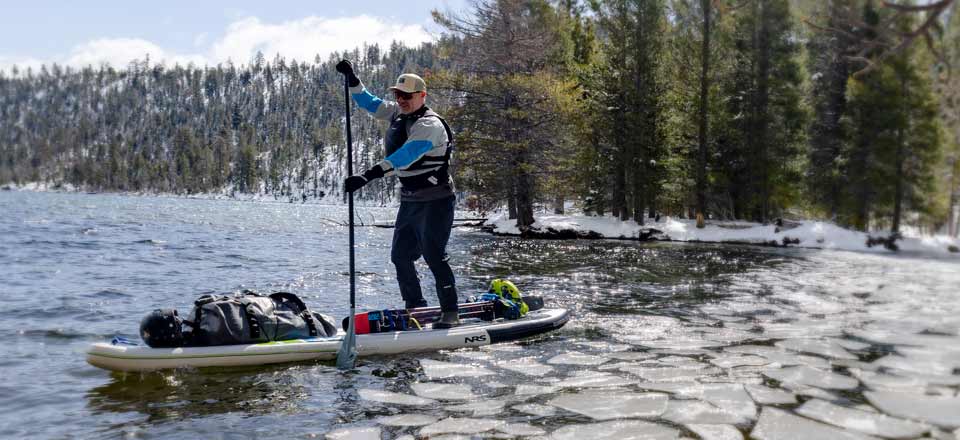
Be aware that you don’t have to be immersed in water to suffer severe heat loss. Splash, spray and rain can soak inadequately protected insulating layers. And rapid cooling takes place when wind evaporates moisture that soaks those outer layers, further increasing the likelihood of a dangerous situation.
All of these factors will determine how you should approach boating in cold water. Remember, you have all the time in the world to prepare for your cold-water excursion. But once you’re out there, you’re out there.
How to Dress for Cold-Water Boating
Boaters, like other outdoor adventurers, are wise to adopt a layering system for their thermal protection. Layers allow you to add and remove pieces to match changing conditions, and help your body maintain a safe, comfortable temperature. These layers fall generally into three categories: base layers, insulating layers and outer layers.
Base Layers
Start with a moisture-wicking layer next to the skin. Synthetic fabrics such as nylon, polyester and polypropylene don’t absorb water and they move moisture from your skin to outer layers. Merino wool wicks moisture and is comfortable against the skin, unlike traditional wool. Do not wear cotton—it is comfortable when dry but absorbs water, dries slowly and loses its insulating value when wet.
The NRS sun protection clothing line is designed specifically for paddlers. Perfectly placed seams create friction-free zones where other clothing can cause irritation for paddlers. The advanced fabrics wick moisture, dry quickly and protect from harmful UV rays. Wear them solo in warmer weather, and layer them when it’s colder.
Insulating Layers
Fabric base layer garments hold in your body’s heat, but need to be kept dry under splash or dry wear. If you anticipate being in the water a fair bit, consider neoprene garments like NRS HydroSkin. Neoprene rubber foam contains thousands of tiny gas bubbles that slow down heat transfer. Neoprene garments need to fit skin-tight to minimize cold-water entry.
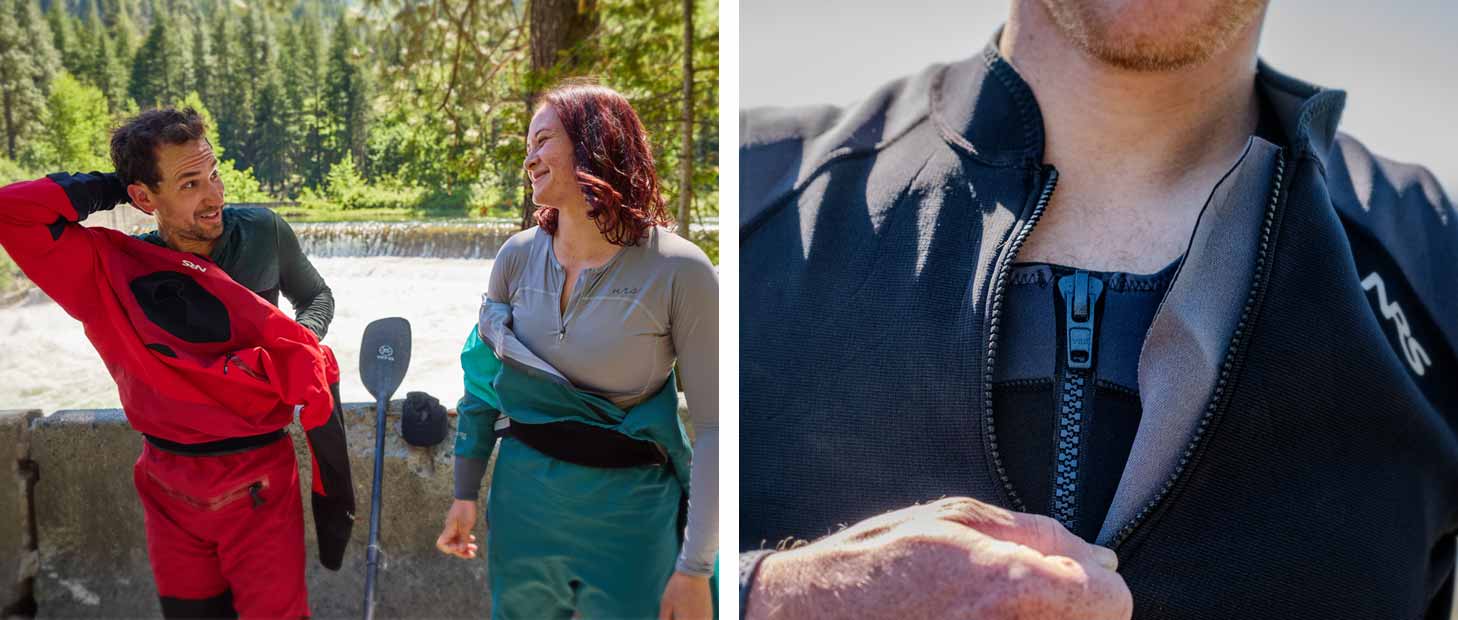
Boaters need upper-body mobility for paddling and rowing, so they usually limit neoprene thickness to 3–4 mm as opposed to thicker neoprene often used in the surfing community.
Tip: Neoprene is inherently non-breathable and designed to retain moisture, so avoid using it to layer underneath dry wear. If you do, you’ll be a sticky, sweaty mess in no time.
Outer Layers
Outer layers round out your body’s core protection system and provide a physical barrier that keeps water and wind out, and heat in. An outer layer made with a breathable membrane is ideal. This allows perspiration to pass out of the garment, keeping the inner layers drier and significantly increasing your comfort and warmth levels.
Splash Wear is simply any waterproof outer layer that is designed to keep your under layers dry if you get splashed or rained on; it’s not meant for submersion. If you do go for a swim in splash wear, your inner layers will get wet.
Semi-Dry Wear is your next step-up in protection. These garments, in tops and full suits, use neoprene gaskets on the neck and either neoprene or latex gaskets on the wrists to block water entry. Neoprene gaskets aren’t as efficient at keeping water out as latex, but they’re more comfortable, less expensive and often provide adequate protection for mild-to-moderate conditions.
Dry Wear can be separate tops and pants, or full-coverage dry suits. These garments use latex gaskets and latex or fabric socks to totally block water entry. This totally dry system allows you to customize your comfort and protection level by adjusting your under layers to match weather and water conditions. Dry suits are ideal for moderate-to-extreme conditions where staying dry is not only a comfort factor, but a safety factor as well.
Protecting Your Extremities
The head is a major source of heat loss. Anyone who’s read, or talked with others, about cold weather protective apparel has heard statements like: “You lose (take your pick—20, 30, 50, 75%) of your heat from your head.” Regardless of the actual percentage, the takeaway is obvious: keeping your head warm is a must.
When you’re on the water, insulated helmet liners and hoods make a great addition to your gear bag. Stash a couple beanies with your street clothes for extra comfort before and after you paddle.
Insulated footwear and neoprene socks protect your feet from the cold and neoprene gloves keep your hands warm and functioning at their best.
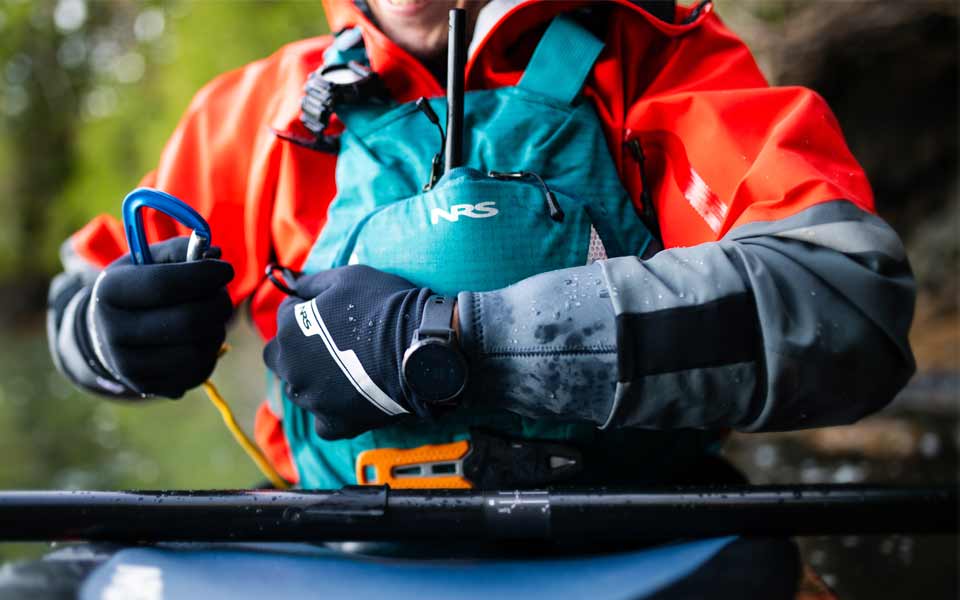
Life Jackets
We can’t stress this enough: wear your PFD. Wearing it any time of the year is the smart thing to do, but it’s doubly important for survival when the water’s cold. Your body exerts energy when it’s trying to stay warm, so there’s no need to use extra energy trying to stay afloat when a PFD can do the bulk of that work for you.
It’s vital that you protect yourself from excess heat loss. Most fatalities during cold-water boating result from drowning in association with incapacitation caused by the cold or from hypothermia. There is absolutely no excuse for not outfitting yourself with protection from cold-water heat loss. If you don’t, you’re really rolling the dice.
Why Water Temperature Matters When Choosing Cold-Water Apparel
Always dress as though you expect to swim. Since water sucks heat away from your body 25 times faster than air, going into the water unprotected can be deadly.
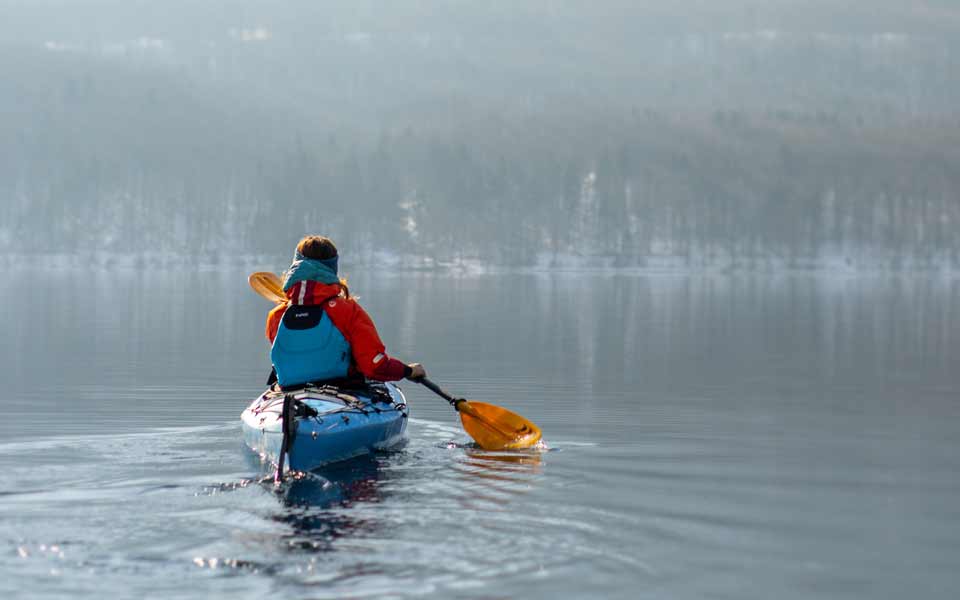
Going for a swim inadequately protected is dangerous in several ways.
- Cold shock drowning: Flipping into cold water produces a gasp reflex and hyperventilation breathing that can cause you to suck in water and lead to quick drowning.
- Reduced mobility: Immersion in cold water rapidly cools the body causing a loss of muscle mobility and brain function. This makes it hard to self-rescue and keep your head out of the water. Wearing a life jacket helps keep you buoyant but in rough water as you become impaired you can still suck in water and drown.
- Hypothermia: With long-term immersion in colder water, heat loss leads to hypothermia, where the body’s core temperature drops below the point where your metabolism and organs can maintain life.
There is no magic formula that answers the question, “When the water is n degrees, what should I wear to be safe?” Your tolerance to cold, physical fitness, distance from land where you’re paddling, self-rescue skills, the skills of your boating companions and other factors are all variables that affect your choices.
Once You’ve Gotten Your Cold-Water Gear
Get in the water with it! Do this in safe conditions, close to shore, with buddies there to help if you get in trouble.
- Start slow. Don’t jump right into a big expedition or long trip. Spend some time getting used to boating in cold water.
- Experience what it feels like to plunge into cold water. Did your gear protect you from that gasp reflex? How long can you stay in the water dressed like this?
- Learn from that experience. Adjust your layering accordingly.
- Regularly repeat this experience. Practice self-rescue in water temperatures you’re boating in.
- Boating with others is always a wise choice. In cold weather, it’s especially smart. If you get into trouble, having others who can help rescue, get you to shore and warmed up can be a lifesaver.
- Always wear your life jacket. Always. (Always!)
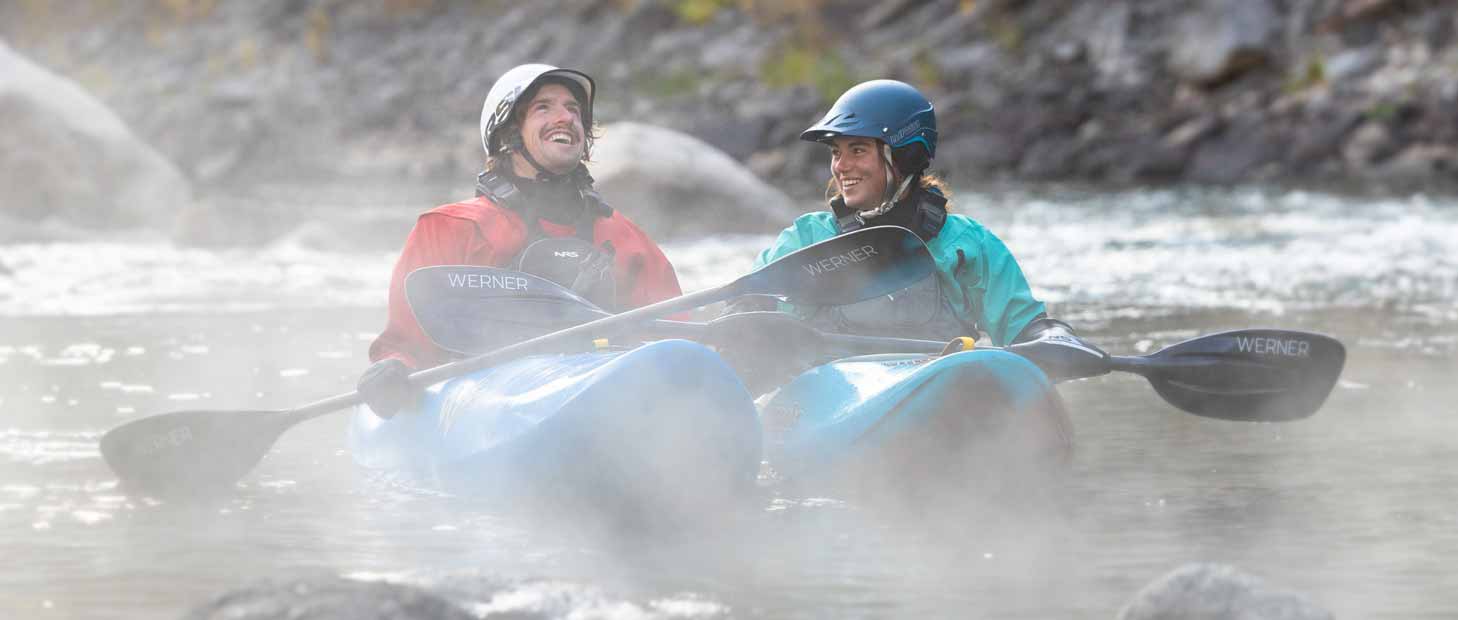
Boating when the water is cold can be a fun and fulfilling experience; when you’re properly protected, you’ll have a great time. Usually, there are fewer people on the water then, you’ll see more varied wildlife and the scenery can be fantastic.
Remember: the best single piece of advice is: “Dress for the swim.” If you’re not properly prepared, at the very least you’ll be uncomfortable and won’t enjoy the trip. At the worst, you become one of those statistics we read about.
Cold-Water Boating Resources for Safety and Preparation
Knowledge is power. There are many great resources available to help you prepare and make the most of boating when it’s cold.
- Consult your local paddlesports dealer to find out what’s recommended for conditions in your area.
- Seek out boating clubs in your area and learn from their experience.
- Utilize apps like PaddleWays to get paddler-specific info on the area you’ll be boating.
- For specific questions regarding NRS products, contact us!
Be prepared, be safe and have fun!
 NRS Gift Card: Always Fits, Always Wanted
NRS Gift Card: Always Fits, Always Wanted




